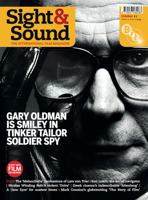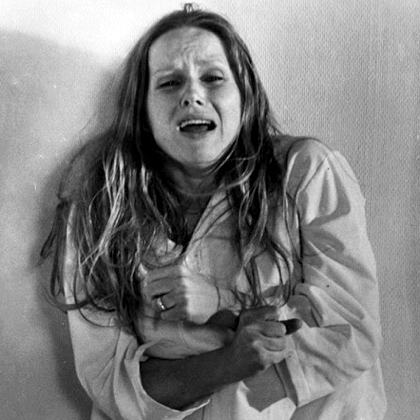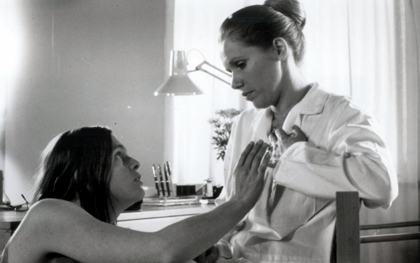Primary navigation


An intense, stripped-bare psychodrama, Face to Face reminds us why Bergman’s films are essential viewing, says Michael Atkinson
Face to Face
Ingmar Bergman; Sweden 1976; Olive Films / Region 1 NTSC; 136 minutes; Aspect Ratio 1.78:1
The major Bergman film previously unavailable on English-subtitled DVD, this international psychodramatic hit (and double Oscar nominee) came well into the director’s comfortable mandarin period, amid Scenes from a Marriage (1973), The Magic Flute (1975) and Autumn Sonata (1978), though it feels in its particulars more like a film made seven or ten years earlier, when the globally beloved Swede was busy messing around with super-ego surrealism and limning in his unique way the interiority of psychological struggle.
In fact, it may’ve been about this time, with the middle-ageing of the art-film era and the sense of histrionic repetition in Bergman’s oeuvre, that the isolated master was beginning to be thought of in more derisive terms; going back as far as the satirical 1968 short De Düva and looking ahead to the unforgettable Count Floyd Whispers of the Wolf episode on Canadian sketch show SCTV in 1978, things Bergmanesque – overt psychological symbolism, brooding seriousness, screaming spiritual crisis, Scanda-angst – became grist for farce. Bergman may have seemed in his meridian to be an indomitable voice, but his pantheon status since has been as fragile as an eggshell.
Still, as cinephiles with memories know, fashion will not win in the end, and Bergman, a classical giant with massive modernist ordnance, will re-emerge as essential for all ages, once we again embrace earnestness and overt truth-seeking as acceptable cinematic ambitions. (No one, not even Antonioni, was as irony-free as Bergman.)
Face to Face is certainly a test case, going full bore into rubber-room dramatics with a toxic amperage only rivalled by Cassavetes. No less than Through a Glass Darkly (1961) or Hour of the Wolf (1968), the movie dives directly into the freefall of a psychotic break, beginning incrementally as Liv Ullmann’s buttoned-down hospital shrink Jenny bunks with her grandparents while her husband is away at a conference and their new house is still being built.
Everything seems perfectly sunny and successful, even after she dallies with a suave writer (Erland Josephson) at a party thrown by an ageing diva surrounded by gay boy-toys, and becomes gradually besieged by nightmares and visions. Pursuing a runaway patient to her own empty house, she is confronted by the deus ex machina of a pair of thugs, who try, unsuccessfully, to rape her (in a brilliant, unmoving bifurcated master shot). She shrugs off the assault as if it were a retail-clerk rudeness, but thereafter her grip on ordinary life starts to slip, and as her carefully hidden secrets hit the open air we witness as we haven’t in many other films a whole-hog descent into madness.

Bergman’s lock-step Freudianism may look a tad old-fashioned today, like an adaptive take on the recorded dreams of Sigmund’s more famous hysterics. But the energy of his storytelling and his immersive way with actors never ages. By 1976 the filmmaker had swapped his mysterious, crepuscular, image-driven mode for gritty, unadorned realism, and Face to Face rather boldly dives into symbol-laden subconscious sequences brimming with trite theatricality (Ullmann lurching through rooms in a blood-red nun’s coif and robes, and trapped in small rooms sardine-packed with disfigured patients) that baldly illustrates the heroine’s inner crisis.
But unsurprisingly the unblinking commitment of both director and actress muster a gravitational field difficult to resist; if cinema is essentially voyeurism, allowing us to safely observe the tortured private moments of strangers, then the meltdown sequences of Face to Face may be among the medium’s most characteristic passages. With this film, more so than even Scenes from a Marriage, Ullmann became the decade’s stripped-bare mega-thespian, capable of dragging us into a character’s selfless, howling turmoil and making the trial uncomfortably convincing.
Of course, Face to Face, like so many of Bergman’s mature films, remains a powerful feminist document, in which the conflicts and pressures of a modern woman’s life create a literal rupture in her reality, a post-Germaine Greer revisiting of The Wide Sargasso Sea in the context of a professional-class female’s supposedly stable, privileged existence. This remains a way to grasp Bergman’s films despite their sometimes out-of-date devices and never let go – their relevance as yowls of feminist frustration still rings. If for Bergman life seemed to be one long, painful therapy session, then it remained for his female protagonists a process left unresolved, with lingering questions and needs no man can fulfil.
Bergmaniacs will pounce on this long-awaited release, which ends a drought that’s apparently been due to a simple lack of suitable materials. The Olive Films edition is a decent print but not a restoration, and the transfer has a touch of noticeably grey droopiness in the dark scenes. But the quality is generally fine, and the film vibrates with passion.
The three o’clock rite: Lena Bergman remembers her father’s viewing habits in his unique private cinema (June 2011)
Bergman the changeling?: Geoffrey Macnab on the late Swedish master’s posthumous family wrangles (June 2010)
Saraband reviewed by Jonathan Romney (October 2005)
Stealing beauty: Terence Davies, Lukas Moodysson, Thomas Vinterberg and Gillies MacKinnon on the Bergman scenes that have meant most to them (January 2003)
Faithless reviewed by Philip Strick (February 2001)